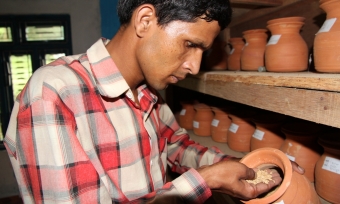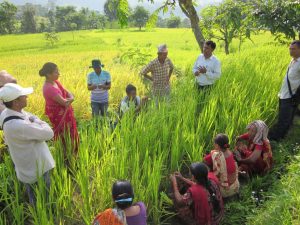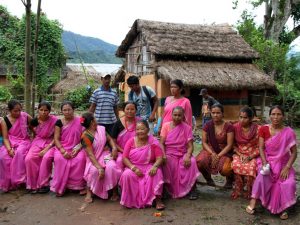
Laxima Adhikari, a farmer in Nepal, used to suffer from an unstable supply of seeds, especially when drought affected her crops. Now, she boasts of bountiful harvests from rice and vegetable crops grown during the winter season. What caused this transformation?
In Nepal, more than 70% of the population depends on rice for livelihood. Half of the cultivated areas are planted with rice, which is grown on 1.48 million hectares, 27% of which are in midhills and mountains, and the rest are in foothills and plains (terai).
Although rice is a staple food, the supply of good seeds is limited. The country needs almost 80,000 tons of seed annually but only 9% is supplied by private seed companies and national agencies and these seeds are usually from the farmers’ produce. Farmers therefore risk poor harvests because of low-quality seeds, often combined with a lack of inputs and inappropriate crop management practices.
Only 70% of the farming communities usually achieve food security for more than half of the year. If environmental conditions turn unfavorable, only 30% of the communities have enough rice on the table. Ensuring good-quality seeds for a more stable and sustainable supply is therefore a challenge.

In 2005, a participatory research project (IFAD-TAG 706) began to tackle food security and environmental sustainability in marginal uplands. It was funded by the International Fund for Agricultural Development (IFAD) in partnership with the Institute of Agriculture and Animal Science (IAAS). The project selected the Sundarbazar Village Development Committee (VDC) in Lamjung District in midhills (900–1,500 meters above sea level) as a key research site.
Farmer field trials, farmer acceptance tests, varietal demonstrations, and minikit programs allowed farmers to test promising rice varieties obtained from IRRI and the National Rice Research Program (NRRP). The farmers were interested in varieties that produce high yield, resist drought, have good and eating quality, tolerate pests and diseases, and command a better price in the market.
Within a short time, four upland rice varieties (Radha-32, Ghaiya-2, IR55435-5, and Pakhejhinuwa) and six for lowland rice (Radha-4, Ram Dhan, Barkhe-3017, Sunaulo sugandha, Barkhe-2024, and NR-1824-21-1-1) were identified as superior to local lines. These were ready for dissemination during the third year of the project in six more villages with similar agroclimatic conditions in Lamjung, Tanahun, and Gorkha districts.
The community has the answer

Word went around that new varieties were available, and requests from farmers came pouring in. What was needed, however, was a viable seed system that could provide a timely and adequate seed supply of good-quality and suitable varieties.
With no private seed companies or a government program to provide the much-needed seeds, the project team embarked on a community-based seed production program to meet this challenge.
The team could not have chosen a better time: the farmers were very receptive to the idea of forming their own seed production system. Years of lack of seed supplies became a driving force for farmers to act together. As a result, the Sundar Seed Cooperative, Ltd., became the first seed producers’ group (SPG) in Sundarbazar, Lamjung, in 2007.
“Our dream is to produce enough quality seeds to ensure good harvests and sufficient food on the table,” said Krishna Prasad Siluwal, first chairperson of Sundar Seed Cooperative. And, more importantly, the program allows farmers to preserve their time-honored and socioeconomically significant varieties in the villages.
This SPG produced 4 tons of seeds in the first year, 20 tons the following year with about 1,000 farmer-buyers, and 30 tons in the third year. Its members hope to serve at least 3,000 farmers.
As more farmers see the performance of new varieties, demand for seeds increases. Unfortunately, the cooperative can meet only 11% of the total demand for seeds in the villages of Lamjung and neighboring districts.
“We not only hope for ourselves; we also aspire to help other farmers in the same predicament,” said Khila Sharma Bagale, Pragati SPG president. “There is unity in poverty, but we are determined to break this cycle and rise, given opportunities.”
Capturing the ripple effect
Not long after the IFAD project (TAG 706) finished in 2009, the Consortium for Unfavorable Rice Environments (CURE) continued the work. A good model for development should not end with the project. Lessons learned should be replicated as hundreds of thousands of farmers are in need of good seeds of new and improved stress-tolerant varieties.
So, in 2010, under the auspices of CURE, the project partners formed seven new SPGs in seven villages in Lamjung, Tanahun, and Gorkha districts. In these villages, more and more farmers see the fruits of their labor as they participate in seed production of upland rice, legumes, oilseed crops, and vegetable crops.
In 2010, all seven SPGs and the two cooperatives produced a total of 169 tons of seed (14 tons of upland rice and 155 tons of lowland rice). The Sundar Seed Cooperative is the center for seed production, collection, and distribution. It collected and sold 20% of the farmers’ total production.
Women not to be outdone

Following the success of the first SPG, the Purkot Seed Producers’ Group (now, Pragati SPG) was established in 2008 under the leadership of a progressive farmer, Mrs. Gita Pandey, in Tanahun District. Then, the Harrabot Ladies’ Seed Producers’ Group was formed in 2010 through the initiative of Laxima Adhikari. She remarked, “When I observed that men were doing well in their seed production, I was challenged, and thought that what men can do, we can do better.
“Now, we can help our husbands earn income without affecting our household chores since we do farming activities mostly in our own backyard or on nearby farms,” she added.
The women saw opportunities in leadership training activities through the project. Since then, they learned to grow other crops and their families can now eat a variety of off-season crops such as cabbage, cauliflower, and leafy vegetables. Millet and maize that used to replace rice on the table are now feeds for livestock and poultry. Beekeeping and goat raising have also been constant sources of additional income.
___________________________________________________
Ms. Manzanilla is currently a Scientist 1 (social sciences) at the International Rice Research Institute under the Consortium for Unfavorable Rice Environments (CURE).
Mr. Johnson is Leader for Sustainable Rice-based Production Systems theme and Head, Crop and Environmental Sciences Division (CESD).







